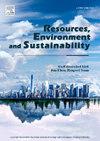Carbon footprint of global cotton production
IF 12.4
Q1 ENVIRONMENTAL SCIENCES
引用次数: 0
Abstract
Cotton constitutes one-quarter of the global fiber market. With growing global attention to the carbon footprint and net-zero pathways of the fashion and textile industries, it is essential to quantify the life-cycle greenhouse gas (GHG) emissions, or carbon footprint, of cotton production and develop effective emission reduction strategies. Based on life-cycle assessment, we estimate that global GHG emissions from cotton production in 2020 amounts to approximately 63 Mt CO2e, with substantial regional variability observed. Emissions intensity ranges from 0.3 to 1.4 t CO2e per t of cotton produced, with an average of 0.9 t CO2e per t or 1.9 t CO2e per t of fiber produced. Across the countries evaluated, India has the most GHG emissions and, hence, the largest reduction potential, highlighting the need for prioritized localized strategies in that region. Nitrogen fertilizer is identified as the main driver of cotton’s carbon footprint, due to direct O emissions and indirect GHG emissions from production. In some regions, phosphorus (O5) fertilizer and diesel use are also important sources of emissions. Scenario analysis indicates that cotton’s carbon footprint can be reduced by 37% through improving nitrogen use efficiency and increasing manure application, and an additional 12% reduction is possible by powering farm equipment with renewable energy. Our study provides important information for decision makers regarding how to make global cotton production more sustainable and climate friendly.

全球棉花生产的碳足迹
棉花占全球纤维市场的四分之一。随着全球对时尚和纺织行业碳足迹和净零排放途径的关注日益增加,量化棉花生产的生命周期温室气体(GHG)排放或碳足迹并制定有效的减排战略至关重要。基于生命周期评估,我们估计2020年棉花生产产生的全球温室气体排放量约为6300万吨二氧化碳当量,存在显著的区域差异。每生产1吨棉花,排放强度为0.3至1.4吨二氧化碳当量,每生产1吨纤维,排放强度平均为0.9吨二氧化碳当量或1.9吨二氧化碳当量。在评估的所有国家中,印度的温室气体排放量最多,因此减排潜力最大,突出表明该地区需要优先制定本地化战略。氮肥被认为是棉花碳足迹的主要驱动因素,因为生产过程中直接排放一氧化二氮和间接排放温室气体。在一些地区,磷(P2O5)肥料和柴油的使用也是重要的排放源。情景分析表明,通过提高氮利用效率和增加肥料施用,棉花的碳足迹可以减少~ 37%,通过使用可再生能源为农业设备供电,还可以减少~ 12%。我们的研究为决策者提供了关于如何使全球棉花生产更加可持续和气候友好的重要信息。
本文章由计算机程序翻译,如有差异,请以英文原文为准。
求助全文
约1分钟内获得全文
求助全文
来源期刊

Resources Environment and Sustainability
Environmental Science-Environmental Science (miscellaneous)
CiteScore
15.10
自引率
0.00%
发文量
41
审稿时长
33 days
 求助内容:
求助内容: 应助结果提醒方式:
应助结果提醒方式:


